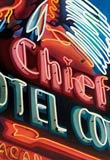
Thank you for taking the time to look at my art. I work exclusively in oil paint on either stretched canvas or hardboard panels. Each painting is completed in a series of several layers, which are allowed to dry completely between “coats.” I build up the color and texture until I am satisfied with the finished image. Most finished paintings have between three to five layers. Because of the drying time required for oil paint I frequently work on several paintings at a time, each in a varying stage of completion. I have categorized the paintings by subject matter to showcase cohesive bodies of work. Each category includes a statement about the work contained within. Click any thumbnail to see details including size, title, and year produced.
For three weeks in December of 2011 I got to indulge my long-time dream of driving the length of Route 66 from Chicago to Los Angeles. I raised money for the project via a Kickstarter campaign. The goal – take photos of signs and roadside attractions and complete 66 paintings.
You can see the original Kickstarter campaign here.
And if you’d like to read my trip journal, please visit the blog.
Most of my earlier paintings depict signs as they are seen looking up from below, which is readily apparent if you view the “Signs” portfolio. This composition came about naturally because I work from photographs and most signs are mounted high off the ground. Unless you are willing to get on a tall ladder (which I am not because I’m a chicken with heights) that is the angle that is easiest to photograph. Over time, I noticed that this angle forced me to incorporate a large portion of the sky in the image and I was starting to feel like the compositions were becoming very static. I wanted to find a way to maintain a focus on detail while infusing the compositions with a sense of movement and energy.
I call the paintings in this section “fragments,” and they are a natural evolution from my earlier work. I found the solution I sought simply by looking closer. What at first glance may appear to be abstract images are actually photorealistic depictions of old signs – just zoomed in to focus on specific details. Removing any reference to the ground or sky frees me to compose the images in whatever manner I find most suitable and allows me to play up the little details. I particularly enjoy watching people view these pieces at shows because at first they usually can’t tell what they’re looking at, then all of a sudden it “clicks” and the image becomes recognizable.Neon signs of all kinds - but especially those in a state of neglect and decay - are irresistible to me. Viewed purely as objects, they provide an interesting variety of reflective surfaces, rust, peeling paint, glowing light and deep shadows that I find both a challenge and a joy to paint. The signs are works of art in their own right.
During the burgeoning days of car culture, neon signs served the functional purpose of attracting patrons to various businesses. They were the visual equivalent of screaming, “Look at me!” I love the duality inherent in neon – a vivid, fluid, transcendent medium that historically has been used almost exclusively for the promotion of banal, commercial interests.
These signs are remnants of an America that no longer exists, and most likely never did exist – at least not in the way I imagine it. Though many buildings have been demolished and most old signs end up in junkyards, some still pepper our landscape, ruins of a lost age. As artifacts of American culture, neon signs illuminate both our character and our history.
When I was invited to have a show at the Warehouse Theatre in Greenville in conjunction with the production of Screwtape, I decided I wanted the work to relate in some way with the play. The story centers around two demons that are plotting to steal a man’s soul. This led me to contemplate the idea of sin, specifically the seven deadly sins. I wanted to find an unusual way to present them, and found the answer in an everyday item – sugar.
The harvesting and refining of sugar has made an indelible impact on human history, primarily in the last five centuries. All of the deadly sins are evident – gluttony, most obviously – but also pride, as it was once only a substance available to the rich; envy, because the poor wanted it; wrath, tied to the slave trade which began in earnest when sugar became a cultivated crop; lust, evident as “sugar cravings;” greed, in the heavy taxation of the early sugar trade and later monopolization of the trade by corporations; and sloth, observed in the laziness that comes after a sugar binge from the resulting “sugar crash.”
The Domino Sugar Refinery serves as a perfect visual metaphor for sugar and all it represents. In addition to being a historic building and a visual icon, it is also quite brooding and ominous in appearance, perfectly suiting the theme of the show. The large scale of the paintings helps convey a sense of oppression by having the images loom over the viewer.
For a short history of the Domino Sugar Refinery, please click here.